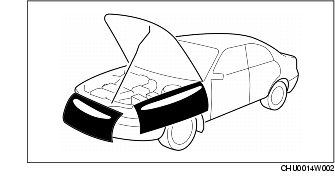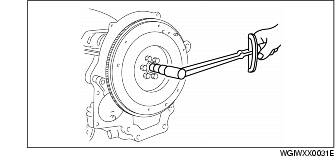SERVICE CAUTIONS
Protection of the Vehicle
Preparation of Tools and Measuring Equipment
Special Service Tools
Disconnection of the Negative Battery Cable
Oil Leakage Inspection
Using UV light (black light)
1. Remove any oil on the engine or transaxle.
- • Referring to the fluorescent dye instruction manual, mix the specified amount of dye into the engine oil or ATF (or transaxle oil).
2. Pour the fluorescent dye into the engine oil or ATF (or transaxle oil).
3. Allow the engine to run for 30 min.
4. Inspect for dye leakage by irradiating with UV light (black light), and identify the type of oil that is leaking.
5. If no dye leakage is found, allow the engine to run for another 30 min. or drive the vehicle then reinspect.
6. Find where the oil is leaking from, then make necessary repairs.
- • To determine whether it is necessary to replace the oil after adding the fluorescent dye, refer to the fluorescent dye instruction manual.
Not using UV light (black light)
1. Gather some of the leaking oil using an absorbent white tissue.
2. Take samples of engine oil and ATF (or transaxle oil), both from the dipstick, and place them next to the leaked oil already gathered on the tissue.
3. Compare the appearance and smell, and identify the type of oil that is leaking.
4. Remove any oil on the engine or transaxle.
5. Allow the engine to run for 30 min.
6. Check the area where the oil is leaking, then make necessary repairs.
Removal of Parts
Disassembly
Inspection During Removal, Disassembly
Arrangement of Parts
Cleaning of Parts
- • Using compressed air can cause dirt and other particles to fly out causing injury to the eyes. Wear protective eye wear whenever using compressed air.
Reassembly
- - Sealant and gaskets, or both, should be applied to specified locations. When sealant is applied, parts should be installed before sealant hardens to prevent leakage.
- - Oil should be applied to the moving components of parts.
- - Specified oil or grease should be applied at the prescribed locations (such as oil seals) before reassembly.
Adjustment
Rubber Parts and Tubing
Hose Clamps
Torque Formulas
|
Torque Unit
|
Formula
|
|---|---|
|
N·m
|
N·m × [L/(L+A)]
|
|
kgf·m
|
kgf·m × [L/(L+A)]
|
|
kgf·cm
|
kgf·cm × [L/(L+A)]
|
|
ft·lbf
|
ft·lbf × [L/(L+A)]
|
|
in·lbf
|
in·lbf × [L/(L+A)]
|
Vise
Dynamometer
- - Place a fan, preferably a vehicle-speed proportional type, in front of the vehicle.
- - Make sure the vehicle is in a facility with an exhaust gas ventilation system.
- - Since the rear bumper might deform from the heat, cool the rear with a fan. (Surface of the bumper must be below 70°C {158°F} degrees.)
- - Keep the area around the vehicle uncluttered so that heat does not build up.
- - Watch the water temperature gauge and don't overheat the engine.
- - Avoid added load to the engine and maintain normal driving conditions as much as possible.
- • When only the front or rear wheels are rotated on a chassis dynamometer or equivalent, the ABS/DSC CM determines that there is a malfunction in the ABS/DSC and illuminates the following lights:
- • If the above lights are illuminated, dismount the vehicle from the chassis dynamometer and turn the ignition switch to the LOCK position. Then, turn the ignition switch back to the ON position, run the vehicle at 10 km/h or more and verify that the warning lights go out. In this case, a DTC will be stored in the memory. Clear the DTC from the memory by following the memory clearing procedure [ABS]/[DSC] in the on-board diagnostic system. (See ON-BOARD DIAGNOSIS [ABS] ) (See ON-BOARD DIAGNOSIS [DSC (DYNAMIC STABILITY CONTROL)] )















